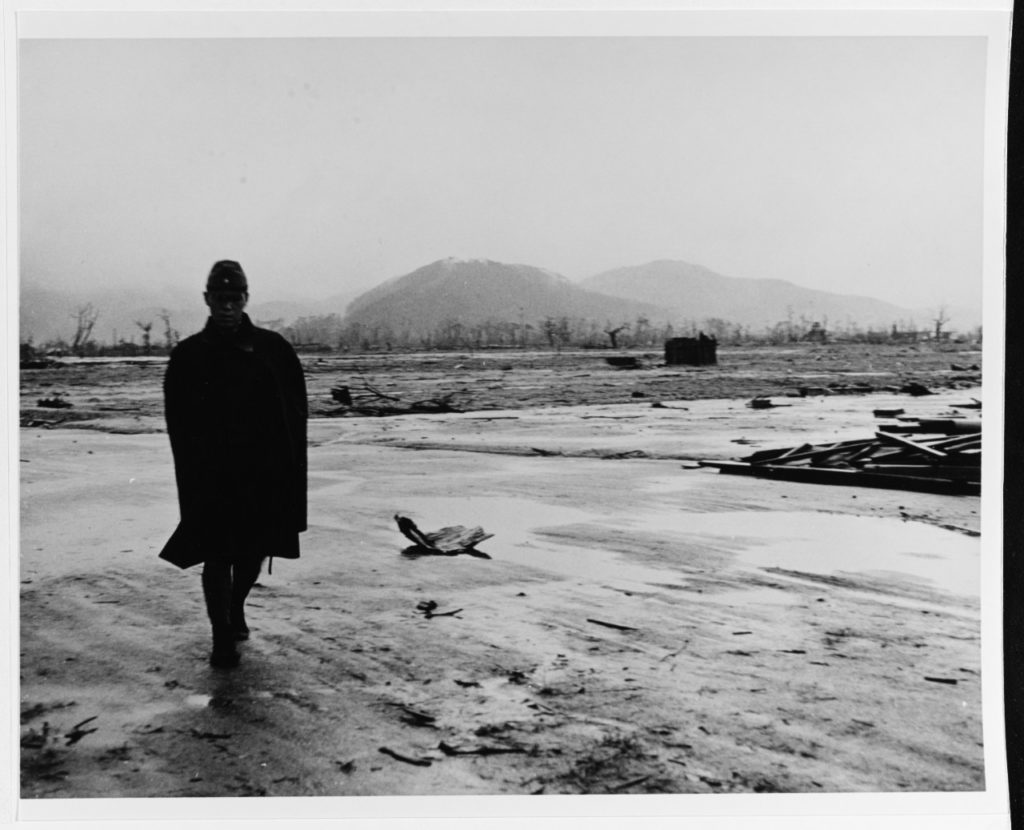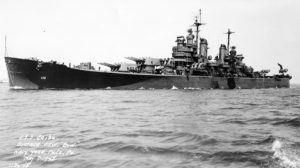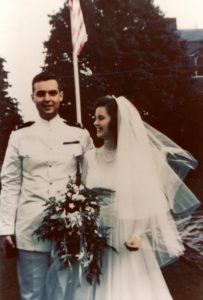
A Japanese soldier walks through the atomic-bomb leveled city, September 1945. Photographed by Lieutenant Wayne Miller, USNR. (Photo # 80-G-473733)
With tomorrow’s 71st anniversary of the dropping of the atomic bomb at Hiroshima which, following a second bomb drop at Nagasaki, led to the Japanese surrender ending World War II, we thought we would share a recent find from our ongoing naval history collection efforts.
As part of the Naval Historical Foundation’s Oral History and Memoir Collection effort, the Naval Historical Foundation has been working with David T. Leighton. Born in California in 1925, Leighton came into a Navy family. His father would attain the rank of rear admiral before stomach cancer would claim his life in 1943.

The U.S. Navy Baltimore-class heavy cruiser USS Chicago (CA-136) off the Philadelphia Navy Yard, Pennsylvania (USA), 7 May 1945. (USN Photograph/NAVSOURCE)
David and his two brothers and sister would also join the Navy. In the case of his older sister Elizabeth, she would be the first ensign sworn in under the WAVE program initiated during World War II. As a member of the Naval Academy Class of 1946, David actually graduated in 1945. Having orders to the USS Indianapolis, he never made it to his destination. He eventually made it to the cruiser USS Chicago which remained as a token American naval presence in support of the occupation forces ashore. En route to his ship, he spent time in San Diego. “That was real luck for me because, due to the delay in leaving San Diego, a good friend introduced me to Helen Milligan. We were married fifteen months later.”
That David tied the knot in just over a year thanks to a long-distance relationship that involved a series of lengthy detailed letters that provided a travelogue of his experiences in and around Japan. David would later write: “In my five-month tour in Japan I had learned a lot in my job, and I also learned a lot about the aftermath of war. I had graduated from the Academy too late to engage in combat, but in Japan, I had ample opportunity to see the results of the devastating non-nuclear attacks on such cities as Tokyo and Yokohama, and the atomic bomb attack on Hiroshima – where the streets had been cleared but little recovery had been accomplished.”
On June 3, 1946, David typed and described what he saw to Helen:
We left Yokosuka Friday for Kure. (This was over a week ago). Kure is on southern Honshu. In order to get there you have to go up the Inland Sea. About 0600 Sunday morning we sighted land and entered the Inland Sea. It had been stormy all day Saturday, but cleared into a perfectly beautiful warm sunny day Sunday. (It took about six hours to get from the entrance up to Kure. We had to twist and turn to follow the channel in. In some places there is only 700yards between islands. The whole inland sea is full of small islands. It looks something like the Puget Sound area expect that all of the islands have hills on them. The hills start right from the water edge. There is no level land on them at all. The Japanese grow something on every piece of land that is fertile enough to grow a weed. All the sides of these hills on all the islands large enough to support people are terraced wherever you look. There are whole fleets of fishing boats in the sea itself. You really have to keep a sharp lookout to keep from running them down. Many of them look like the many pictures you must have seen of Chinese junks with clumsy gaff-rigged sails. Most of them also have small putt-putt engines. It is very hard to describe all this; you really have to see it to tell what I mean. I never was much good at description anyhow. (I’m not very good at typing either, which you can readily see.)
Anyhow about noon we tied up to a buoy in Kure. Kure and the surrounding area are controlled by the British. We have a very small AMG establishment there with two or three American naval officers. All the army there is Australian and Indian and there are a few small ships there. I had the duty Sunday and could not go ashore. The good weather held until the morning we left with was Thursday. Monday three other officers and an enlisted man and myself were lucky enough to get an AMG jeep. We decided to drive to Hiroshima to see what the A-bomb really had done.
The road from Kure to Hiroshima is pretty good as Japanese roads go, which isn’t saying much. Japanese roads are pretty grim to say the least. Anyhow, after many bumps and jolts we arrived. I have seen many ruins in Yokohama and Tokyo. Ruins all look alike. You see everything reduced to rubble. Everything is in little pieces. Bricks are in halves, concrete is broken down, wood is burned, tile is chipped into little hunks. That is the way it is in Tokyo and Yokohama. But there are two noticeable differences in Hiroshima. The first is that only one bomb was dropped there. There were none before and none after. There were many thousands of bombs dropped in Tokyo and Yokohama. The second difference is that in Hiroshima the place is not bombed out in sections, it is flat everywhere. It looks like all the ruins of Tokyo and Yokohama all concentrated in one spot. To be sure there are buildings still standing in Hiroshima. Many of the concrete buildings are still standing, but when you get close to them you can see that the insides are all burned out and that the ceilings are caved in. Some of them are still usable, but most are completely ruined. In Hiroshima you can stand where the bomb hit and look around and you see where a city was. It is amazing. You really can’t believe it until you see it. For miles there is nothing but rubble. It is a sight to see nature in all its splendor through the blown-out remains of what used to be a big business building. It is hard to describe the complete devastation. I am glad that I have seen it for myself.
After sea duty on a light aircraft carrier, David would eventually receive orders to serve with Rear Admiral Rickover. Retiring as a commander, David would continue working for Naval Reactors in a civilian capacity. One of his contributions was to conceptualize the operation of a nuclear-powered aircraft carrier using just two reactors. With the introduction of the Nimitz class carrier, the concept has been proven now for over forty years. Meanwhile, Helen and David had a long-happy marriage, raising two sons. Sadly Helen left us a few years ago leaving David still active at age 91. A proponent of naval history and a member of the Naval Historical Foundation’s Holloway Society, the NHF honors him annually with the David T. Leighton Lecture at its annual June meeting.


